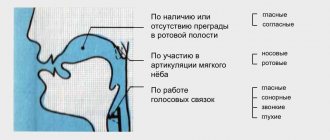CLASSIFICATION OF VOWEL SOUNDS OF THE RUSSIAN LANGUAGE
Vowel sounds are speech sounds produced by the free passage of air through the vocal cords, consisting mainly of the voice (voice tone) with almost no noise.
In Russian, vowels are classified according to three criteria:
1) by row (place of education);
2) by ascent (method of formation);
3) by the presence or absence of labialization.
When classifying vowels into a row, the difference between vowels caused by the movement of the tongue in the horizontal direction is taken into account.
In this case, vowels are divided into three groups:
1) front , during the articulation of which the tongue is strongly moved forward: [i], [e];
2) middle , during the articulation of which the tongue moves slightly back: [s], [a];
back vowels , when pronounced, the tongue is strongly moved back: [u], [o].
When classifying vowels by tongue elevation, the difference between vowels caused by the movement of the tongue in the vertical direction is taken into account. In this case, vowels are divided into three groups:
1) high vowels , during the pronunciation of which the tongue is strongly raised, i.e. occupies the highest position: [i], [s], [y];
mid-rise vowels , during the pronunciation of which the tongue occupies a lower position: [e], [o];
3) lower , during the pronunciation of which the tongue occupies the lowest position: [a].
According to the width of the mouth opening (which is associated with the degree of elevation of the back of the tongue), vowels are divided into:
1) wide, i.e. acoustically the most sonorous: [a];
2) average, i.e. acoustically medium sonority: [e], [o];
3) narrow, i.e. acoustically the least sonorous: [i], [s], [u].
The third sign of classification is the presence or absence of labialization , i.e. stretching or rounding of lips.
In this case, vowels are divided into:
1) labialized vowels (rounded): [u], [o];
2) non-labialized vowels (unrounded): [a], [e], [i], [s].
The classification of vowels can be presented in tables.
The simplest table of articulation of vowel sounds
| Row Lift | Front | Average | Rear |
| Upper | And | s | at |
| Average | uh | O | |
| Lower | A |
The division into three rows and three rises does not reflect the full richness of vowel sounds.
There are so-called reduced vowel sounds: [Λ], [and e], [ы e], [ъ], [ь].
[Λ] – reduced vowel [a], [o] in the first pre-stressed syllable and the absolute beginning of the word; this sound is called “a - narrow”;
[and e] – a sound intermediate between [i] and [e]; this is a sound pronounced with a slightly greater openness of the mouth and a slightly lower rise of the tongue than the sound [and]; the sound is called “[and] open” or “[and] with an overtone [e]”, or “[and] inclined to [e]”;
[s e] – a sound intermediate between [s] and [e]; the sound is called “[s] with an overtone [e]”, or “[s] inclined to [e]”;
[ъ], [ь] – reduced vowels [а], [о], [е] in all unstressed syllables, except the first prestressed one; [ъ] – a sound intermediate between [ы] and [а];
Shades of sounds can be considered as special sounds. Then the vowel table should be more detailed.
Vowel sounds articulation table
| Row Lift | Front | Average | Rear |
| Upper | And | s | at |
| Upper-medium | and uh | ee | |
| Average | uh | ъ | O |
| Lower | and Λ |
LECTURE 5. Principles of sound classification. Vowel sounds and their classification
PRINCIPLES OF SOUND CLASSIFICATION. The most fundamental division of sounds is their division into vowels and consonants (this is a linguistic universal). The difference between vowels and consonants is of an articulatory-acoustic nature. Sounds can generally be formed in two ways: 1) vibration of the vocal cords at the moment a stream of air passes through the larynx - cf. singing; they create the musical tone of sound, or voice; 2) noise, a non-harmonic sound formed as a result of a stream of air overcoming various obstacles. The relationship between voice and noise - there is a DP for vowels and consonants, as well as a DP for further division of consonants. The system of vowel sounds is called vocalism
, consonants -
consonantism
.
Vowel sounds are sounds in the formation of which only the voice is involved, without noise. The distinctive features of vowels are based on how the position of the speech organs changes in the oral cavity - the resonator, in our case - the lips and tongue, giving the sound a different color. These are speech sounds, the main functional feature of which is their role in syllable formation: a vowel always forms the top of a syllable and is a sonant.
A vowel is a speech sound in which the voice, or musical tone, predominates. It is no coincidence that the term “vowel” itself, as well as the corresponding terms in other languages, is associated with the word “voice”. The vowel sound is formed in the larynx due to the vibration of the vocal cords and is a musical tone, on which special characteristic tones (overtones) are layered, formed in the supraglottic cavities - in the pharyngeal cavity and mainly in the oral cavity, which give the sound its specific timbre, its quality .
Emphasizing the difference between vowels and consonants, the following conditions for the formation of vowel sounds are usually noted: free passage of the air stream into the oral cavity (vowels are “mouth openers”), less force of the air stream, diffuse (uniform) tension of the speech organs when pronouncing vowel sounds, non-participation of the nasal cavity, participation of only the voice source.
When articulatory classification of vowels, the position of the tongue is taken into account - the degree of elevation of the tongue towards the hard palate and its advancement forward or backward in the oral cavity and lips, as well as the participation of the lips in the formation of the resonator. There are three differential features for vowels of the Russian language.
1) Row
: that part of the tongue that is involved in the formation of the resonator; it is essentially where the tongue rises in the mouth. The language is conventionally divided into three sections - the front part of the tongue, the middle and the back: according to the advancement, vowels are divided into front row vowels (palatal), front-middle row vowels (central), middle-back row, back row (velar)
2) Climb
: this is the level, the degree of elevation of the tongue in the formation of the resonator.
We conditionally divide it into three degrees - high degree of rise, medium and low. Based on their rise, they distinguish between vowels of the upper (high, narrow, diffuse) and non-upper rise (compact) - medium or low (low, open, wide) .
3) Labialization
: additional participation of the lips in the formation of the resonator (Latin Labium - 'lip'). According to the work of the lips, vowels are divided into rounded (labialized, flat) vowels, during the formation of which the lips are rounded and protruded, and unrounded (non-labialized), during the articulation of which the lips do not play an active role.
When pronouncing high vowels, the back of the tongue rises high to the palate. When pronouncing low vowels, the tongue rises to a minimal extent. When pronouncing mid-rise vowels, the back of the tongue rises slightly towards the palate. When pronouncing front vowels, the body of the tongue moves forward, the tip of the tongue rests on the lower teeth, the middle part of the back of the tongue rises to the hard palate. When pronouncing middle vowels, the middle part of the back of the tongue rises towards the middle palate. When pronouncing back vowels, the body of the tongue is moved back towards the soft palate.
In Russian, six vowels appear in a stressed position, independent of the quality of neighboring consonants. Their articulatory characteristics in terms of rise: vowels of the upper rise [i], [s], [y]; mid-rise vowels [e], [o]; low vowel [a];
characteristics by row: front vowels [i], [e];
back vowels [у], [о]; front-middle vowel [ы]
(starting as a non-front vowel, it usually ends as front), middle vowel [o], which is sometimes classified as back.
In unstressed positions, vowels of the upper middle rise appear ([en] in sh[e»]ptat
front-middle row and [e"] in
p[e"]so, [b]
in
n[b]tachok
of the front row) vowel of the middle row of the middle rise ([ъ] in
s[ъ]dovod),
vowel of the lower (or middle-lower) lifting of the middle (or middle-back) row
([L]
in
s[L]dy).
Unstressed vowels, pronounced with weakened articulation, are shorter and are called reduced, in contrast to fully formed vowels. See reduction.
Let us note that in reality the sounds of the Russian language have other characteristics: say, A is long, and O, on the contrary, is short. But these signs in our language do not oppose sounds to each other (there are no oppositions), and we do not distinguish them from the point of view of meaning: for the Russian ear HOUSE and DOOM sound the same, although in reality they are different things (and an Englishman, for example, will distinguish between the long And in sheap 'sheep' and short in ship 'ship', since these are different words for him, differing only in the sign of length/shortness).
These features of articulation affect the acoustic properties of vowels. The supraglottic cavities, acting as resonators, enhance certain frequencies, vowel formants. When describing the acoustic characteristics of vowels, information about the frequency of two formants is usually used - the first and second. There is a relationship between the frequency of formants and the nature of articulation: the more closed the vowel, the lower the frequency of the first formant, the more back the vowel, the lower the frequency of the second formant. Rounding lowers the frequency of both the first and second formants. The lowest frequency of the first formant is characterized by the high vowels [i], [ы],
[y], the highest frequency of the first formant is in the low vowel
[a].
The second formant has the highest frequency in the front vowel
[i],
and the lowest in the rounded back vowel
\у\.
| Row Lift | Front | Per.-Wed. | Average | Mid-rear | Rear |
| Upper | AND | [s] | * U | ||
| Upper-medium | [ , b] | [yab] | [ ] | ||
| Average | E | [Ъ] | * ABOUT | ||
| Middle-lower | [/\ ] | ||||
| Lower | A |
· Denotes labialization.
Positional variants of the main sounds are placed in square brackets. Total 5 phonemes and 6 positional options.
The remaining sounds in the table are positional variations that arise in the flow of speech in accordance with the current sound laws. They have no independent use, but the table reflects the real articulatory-acoustic characteristics that these sounds have, different from the main ones. By type, the indicated characteristic will be mixed, articulatory-acoustic.
Vowels
Vowels are sounds in which, when pronounced, a stream of air from the lungs passes through the oral cavity freely, without encountering any obstacle, while the vocal cords tremble, and the organs of articulation of the oral cavity are grouped so as to serve as a resonator of the generating sound.
A long, tense, non-labialized, narrow front vowel with a high rise (narrow variety).
For example:
| we | We | these | these |
| meter | counter | recent | recent |
| treat | treat | ceiling | ceiling |
| clean | clean |
A short, unstressed, unlabialized, high-rise front vowel (wide variety).
For example:
| inch | inch | pick | gather |
| since | since then | switch | switch |
| thin | thin | inner | interior |
| middle | middle | simple | simple |
Short, unstressed, unlabialized, front, mid-rise vowel.
For example:
| felt | felt | melt | melt |
| length | length | pencil | pencil |
| head | head | bread | bread |
| weather | weather |
Unlabialized low-rise tense front vowel.
For example:
| man | man | hand | hand |
| stand | stand | angle | corner |
| damp | dampness | matter | matter |
| mass | weight | sat | sat |
Unlabialized long tense low vowel back.
For example:
| art | art | farm | farm |
| dark | dark | park | a park |
| ask | ask | bath | bath |
| father | father | draft | drawing |
Slightly labialized short, low-rise back vowel.
For example:
| not | No | job | service |
| clock | watch | box | box |
| office | office | possible | likely |
| doctor | doctor |
Labialized tense long vowel of the back row of low rise.
For example:
| pause | pause | author | author |
| law | law | draw | paint |
| force | force | form | form |
| short | short | four | four |
Labialized long tense back vowel of high rise.
For example:
| tool | tool | soon | soon |
| cool | chill | choose | choose |
| group | group | soup | soup |
| move | move |
Labialized short, unstressed, high-rise back vowel.
For example:
| book | book | cook | prepare |
| brook | Creek | foot | leg |
| push | push | pull | to pull |
Unlabialized short, unstressed, high-rise back vowel.
For example:
| up | up | cut | cut |
| plus | plus | young | young |
| front | front | mouth | mouth |
| comfort | comfort | wonder | miracle |
Non-labialized long vowel sound of a mixed row of middle rise.
For example:
| term | term | serve | serve |
| fur | fur | turn | twirl |
| third | third | thirst | thirst |
| work | Job | word | word |
An unlabialized short, completely unstressed, always unstressed vowel of a mixed series, most often of medium rise.
For example:
| teacher | teacher | worker | worker |
| chamber | ward | current | flow |
| excellent | great |
Place of tongue elevation
This is also called the vowel formation zone. This takes into account the articulatory movements of the tongue in the horizontal plane. Based on this feature, vowels are distinguished:
- the front row, during the articulation of which the tongue moves forward and its front part rises to the palate: [i], [e];
- back row. The tongue moves back and the back of its back rises: [o], [y];
- middle row. When articulating them, the tongue does not change its horizontal position: [a], [s].
Labialization
Labialization is the position of the lips during articulation in which they are extended forward and rounded, which increases the anterior part of the oral cavity. In relation to this feature, two groups of vowels are distinguished:
- labialized (rounded), during the formation of which the lips are extended into a tube: [o], [y];
- non-labialized (not rounded), during the articulation of which the lips are in a neutral or stretched position. In Russian, these are all vowels except [o] and [u].








